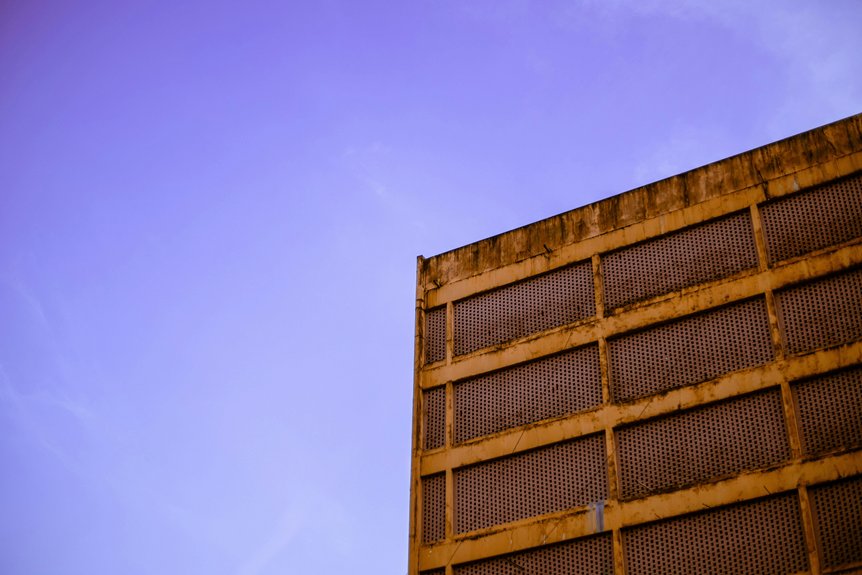Facade mesh is a versatile building material employed for both decorative and functional purposes on exteriors. Various types, such as woven wire, expanded metal, and architectural wire mesh, cater to different design and durability requirements. Common installation methods include steel frames, brackets, and tension profiles, while materials like stainless steel and aluminium provide long-lasting performance.
Proper maintenance can significantly extend its lifespan, ensuring it remains attractive and functional. Further exploration reveals how this innovative material can transform building facades and enhance architectural appeal.
Types and Installation Techniques
There are various types of facade mesh, each designed for specific architectural and functional purposes. Woven wire mesh is popular for its decorative patterns and design flexibility, making it a preferred choice in many applications. Architectural wire mesh is widely used in construction due to its strong aesthetic effects and durability, offering an excellent combination of form and function. Expanded metal mesh provides a cost-effective option with open joints that resist moisture and UV damage, suitable for numerous environments. Metal coil drapery offers a unique aesthetic with its woven sheets, while architectural wire mesh is versatile enough for uses such as facades and partitions. These meshes are available in materials like stainless steel, aluminium, copper, and brass, each coming in a variety of finishes to complement different architectural styles. Installation techniques include attaching galvanised steel frames directly to structures, connecting panels with brackets, and securing them using tension profiles or springs. These methods ensure that the mesh remains firmly in place, contributing to a sleek and durable facade that enhances architectural design.
Material Choices and Maintenance Practices
Selecting the appropriate materials for facade mesh is essential for ensuring durability, aesthetics, and performance in various environments. Materials such as stainless steel, aluminium, copper, and brass, as well as coated steels, provide a balance between strength and weather resistance. Regular maintenance is key to extending their lifespan, which includes gentle cleaning with suitable solutions and avoiding harsh chemicals.
Consider the following material choices:
| Material | Benefits | Maintenance Tips |
|---|---|---|
| Stainless Steel | Corrosion-resistant and robust | Regular passivation and inspections |
| Aluminium | Lightweight and durable | Use pH-neutral cleaning solutions and avoid exposure to salts |
| Copper/Brass | Develops a natural patina | Periodic polishing and application of protective wax |
| Powder-Coated Metals | Offers a weather-resistant finish | Gentle cleaning and checks on coating integrity |
| Galvanised Steel | Provides corrosion protection | Frequent inspections for any rust |
Choosing the right materials and implementing routine upkeep will help maintain the facade’s beauty and structural integrity over time.
Design Benefits and Innovative Applications
The design benefits and innovative applications of facade mesh underscore its versatility and adaptability within contemporary architecture. This material can cover expansive surfaces, rendering it ideal for tall buildings and broad facades due to its tensioned design. Wire mesh, made from high-quality stainless steel, offers excellent corrosion resistance and minimal maintenance requirements, making it suitable for long-term outdoor use. Facade mesh can be tailored to meet specific aesthetic requirements, allowing for the creation of distinctive patterns, varying levels of openness, or branding elements that enhance the uniqueness of a building. Its lightweight construction imparts a modern, industrial appearance while adding textured depth to surfaces. Moreover, facade mesh offers practical advantages such as facilitating natural ventilation, providing solar shading, and aiding in temperature regulation, all of which contribute to improved comfort within the building. The potential applications for facade mesh are extensive, encompassing decorative facades, balconies, partitions, and landscaping features. Ultimately, facade mesh plays a vital role in crafting buildings that exude warmth and connectivity, seamlessly integrating style, functionality, and innovation.
Conclusion
Facade mesh provides adaptable solutions for building exteriors through a variety of types and installation methods. Constructed from robust materials, it necessitates proper maintenance to ensure its longevity.
The advantages of facade mesh include enhanced aesthetics, effective shading, and improved safety. Furthermore, its innovative applications broaden its usage in contemporary architecture.
Overall, facade mesh seamlessly combines functionality with design, making it an ideal choice for architects and builders who are in search of sustainable and visually appealing exterior solutions. By selecting the appropriate materials and ensuring proper care, one can maximise both the performance and visual allure of facade mesh.

